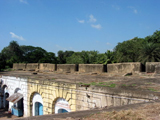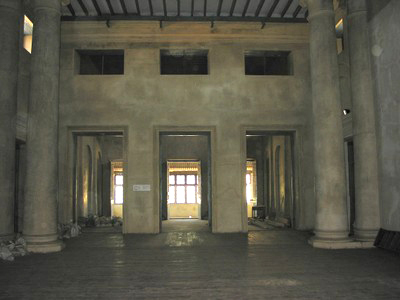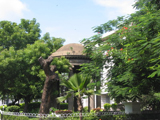|
As another Madras Week gets underway, I recall another August day seven years ago when a large group of us stood in front of Fort St. George, waiting to join a Heritage Walk, an excellent concept put together by a group of hard-working people united by love for their city and its history, and their dedication to share it with the world at large.
We were a truly mixed group, and it was heartening to see a good number of North Indians and even more encouraging to see a healthy scattering of college students, who had clearly come of their own volition.

The crenellated walls.
A clap of the hands, and we were brought to order. We were reminded that parts of the Fort St. George housed the Tamil Nadu Government, parts of it belonged to the Army, and a small portion was under the control of the Archaeological Survey of India. Plus, it was historic property. Therefore we had to behave ourselves, not touch what was not to be touched, and not stray from the group.
We passed the old Governor’s House, now the Tamil Nadu Secretariat and ministers' offices. This handsome building, with its lovely portico, has as its most striking feature 20 granite pillars, made of the best Pallavaram granite. Sadly, whoever was in charge of “restoring” the appearance of these pillars decided that the best way to do it would be by giving them a coat of shining black paint, thus condemning the lovely granite to be forever hidden from view. These pillars have travelled and seen places – built in 1732 as part of a 32-pillar colonnade, they were spirited away to Pondicherry in 1746 by the French, and made their way back to Madras in 1762, when they were placed back in their original site. A few demolitions and renovations later, they were incorporated in the early years of the 20th Century into the portico of the building that is now the Secretariat.
In the growing heat, our group walked on, our steps not quite as brisk and peppy as before. A few minutes later, we spied, looming close by, the clean, simple lines of the spire of the St. Mary’s Church, said to be the oldest Anglican church east of the Suez. We paused awhile in the heavenly shade outside, enjoying the unlikely sounds of organ music in this bastion of Carnatic music. Within its walls – four feet thick and bomb proof – there had worshipped a veritable who’s who of the British Raj.
The last notes of the organ died away, and we entered St. Mary’s Church. I love the atmosphere in an old church, the hushed stillness, the pure serenity, everyone wrapped up in a bubble of their own thoughts and prayers. And when I walked into St. Mary’s, it was no different. But there was something else in the air, and as my eyes adjusted to the darker interior and my body rejoiced at the coolness within, I realised what it was. The ghosts of history. The spirit of the Raj. A sense of being in another era, one of gallantry and chivalry, one filled with hope and despair and suffering and cruelty and fantastic expectations and perilous seas and homesickness and disease and longing for a faraway land and loved ones.

Clive House.
I am one of those who believes that, in balance, the British Raj caused more harm than good in India. But that morning, in the church, something of the romance of the Raj, captured in so many books and movies, touched me. The church was filled with tombstones, many of them with very moving epitaphs, as they told of young men and women who died young in the cause of serving their Empire, people who toiled in conditions their bodies, accustomed to cool Northern climes, simply could not cope with. Something of their sincerity of purpose, their hard-working dedication to empire-building, the harsh conditions they had to endure, came through in these inscriptions.
There were other treasures, too: the teakwood balustrade, the organ, the altar piece, a huge painting of The Last Supper, simple but lovely stained glass windows. Here, Elihu Yale got married, the first marriage to be celebrated in St. Mary’s, and Robert Clive was married here, too. Outside, the lush gardens were cool and quiet, and the only sounds were the songs of the birds and the rustle of the trees in the wind. It was enchanting.
The spell was broken when we left the church and walked towards Clive House (first called Admiralty House). We climbed up a flight of steps into a large room with high ceilings and many pillars along the side. The room was a mess – dusty, decrepit, with peeling paint, and monstrous-looking construction equipment flung haphazardly around. It was a sad sight, even sadder, considering the grand times the building had seen. It was originally the site of the Court of Admiralty, where those merchants and traders who dared bypass or disobey the East India Company and its licensing requirements, as well as an assortment of pirates, fugitives and mutineers, were tried and punished for their crimes. Later Robert Clive and his bride moved in, and there must surely have been some grand balls and parties in that stately mansion, the fabled pomp and splendour of the British Raj.
We walked on past the Grand Arsenal (apparently some sort of a top-secret location, but nobody seemed to know, or want to reveal why, and we were only allowed to gaze at it from a respectful distance – not that there was much to gaze at – and not take photographs), and then towards the north-eastern part of the complex, where the walls that surrounded the Fort complex still stand. Beyond these thick walls lay Black Town, where the Natives lived their supposedly unpious and heathen lives. These walls, 6 metres high, are crenellated, for gun placement and use, mostly against the never-say-die French. The views were magnificent, but you also got the sense of being in a garrison, of being enclosed within a place that afforded protection from outside elements and the many dangers that those within the Fort must have felt and faced.
We walked down the steps, and, hugging the northern boundary of the complex, passed many army barracks, including the Kings Barracks which, with over 10,000 square metres of space, is the largest of its kind in India (I think). Today, it houses the Army’s cafeteria and canteen although, gazing through their gates, it was easy to imagine a thousand high-spirited, or lonely, or friendless or popular young men who lived there, cheek-by-jowl with their mates, like in any college dormitory today.
Finally, we stopped to admire the cupola where the statue of Cornwallis had once stood (now protected against the elements in the Fort Museum), and at the many intricately carved cannons that still face seaward.

The Cornwallis cupola.
Where the Fort Museum is today once stood a house belonging to a merchant. The East India Company “acquired” it from him (eminent domain of the 18th century?), demolished it, and built the present building in the late 1780s. Initially, this was the Madras Bank, and upstairs was the Public Exchange Hall, the hub of all trading activities for several decades. Later still, until the 1940s, it served as the Officers’ Mess. In 1948 the building was made into a museum to house numerous colonial-era treasures. Today, it is a wonderful surprise.
Why do I care so much about Madras? I was born there. I attended school and college there. Most of my close family members live there. I now live far away in New York, but like a homing pigeon I make my way there at least once a year.
I love the place with an irrational ardour. Irrational, because, yes, the place drives me crazy with its traffic which gets worse every time I go there, the potholes, the water problems, the pollution, the shenanigans of its revenge-hungry politicians, the heat, the mosquitoes, the ridiculously ugly buildings that are sprouting like warts on a witch’s nose, the filthy beaches, the lack of civic sense, the lack of discipline, the growing rudeness and the “Delhi-isation” of the city. Do I sound enough like a nose-up-in-the-air NRI?
But I am not one. Everyone I know who lives in Madras says the same things. And I say them, too, because I love Madras. I need it to recharge my batteries and rediscover my humanity. I love its gossipy maamis and the jasmine flowers, the sense that this is one big village where everyone knows everyone else, the Kanjivaram pattus and the golus, the music season and Kalakshetra, Dakshina�Chitra and Murugan Idli Kadai and (god help my soul) the Madras Club, the softness and the graciousness and the kindness and the genuineness of the people, the old-fashioned courtesy and charm which are still there, Delhi-isation or not. It is a mad, crazy, chaotic city, but it has a real heart and soul. And this will not vanish.
I am now certain that whatever else is happening in Madras, there is a bright nugget of hope. The Heritage Walk proved that. I know that now there are people who care enough for Madras that they will fight tooth and nail to preserve something of the character and history of the place. And that is something to cheer about.
– C. Kamini Dandapani
The Armenians too join the celebrations
It is that time of the year when friends and rookies working at the city newspapers call me for leads and itsy-bits on our city.
You must be aware that August is the time when we celebrate this city, from Madras Day to Madras Week (www. themadrasday.in).

The Trap of Glory, by Shahamirian
was written and published
here.
It is a time when I must prepare to lead a cub reporter to a stone that lies alongside the Marmalong Bridge in Saidapet, with an Armenian legend tarred into the earth. Or help the rookie negotiate the pavements in San Thomé to another Armenian tablet on the outer wall of a church which now stands inside the local school campus.
Yes, this city has lots of Armenian history. Earlier this year, I played host to two Armenian sisters who now live in France. Satenig, a scholar, was here to complete her study of the Armenian who, while in this city, dreamt of a constitution for a free Armenia state.

In 1794, Azdarar, the first
Armenian periodical headed by
Haruthyun Shmavonian, was
published in this churchyard.
Yes, a visit to the Armenian Church was on. This must be among the Top 5 places of tranquillity in our city. If you are here on a Sunday, time it for 9.30 a.m. when caretaker Trevor, who has lots of Old George Town stories to share, rings the bells. Six of them, 18th Century vintage. And a form of weekly prayer at a church where a lone lit lamp stands on the altar and few really pray.
Satenig and a group of Armenians from France and in India are now curating events for Madras Week.
A decade and more since this unique idea got rolling, Madras Week seems to be taking on a �fascinating life of its own.
At local levels. Internationally. And in other forms. All this is good for the future.
Slowly, academicians are also tuning in. Sundar from the famed Roja Muthiah Library in Taramani says that among the talks listed for this occasion is one by Dr. Perundevi Srinivasan who will present a paper on ‘Mariyamman at the interface of Science and Religion. And Dr. Karen from the Madras Institute of Development Studies in Adyar says that her institute plans to �curate a seminar on settlements on the city’s waterways.
Last week, a group undertook a tour alongside the Cooum and this project has the potential for documentation and study.
Research, study tours, writing and literature on this city must be encouraged. Small beginnings in little backyards will make this possible. (Courtesy: Adyar Times)
- Vincent D’Souza
Penang �recalls �Madras birthday
The photo exhibition Chennai Nalla Chennai by S.A. Ramesh from Chennai has 68 photographs covering the various facets of Chennai, a city which has a special resonance in Malaysia. The exhibition is a visual feast of Chennai, its way of life, customs and people, landmarks, quirks and what makes the city tick. The photos capture the soul of the city. Also on display are some extraordinary temple compositions. The exhibi�tion’s title is a take on the popular 1967 Tamil movie song Madras Nalla Madras.
Madras Week goes App
As the number of events being held for celebrating the founding of our city keeps increasing, we at Madras Musings realise that it becomes difficult for many of you to keep abreast. There may be many events that you may want to be a part of or you may simply want to know of events that are taking place in your neighbourhood. We are, therefore, launching a mobile app. Developed by Broadgate Technical Services Pvt Ltd, the app has been sponsored by Sundaram Finance Limited, who have been one of the staunch supporters of all activities connected with heritage in this city.
Titled Madras Week, it is a free download from Android stores and app stores. It is compatible with Android and ios phones. So go ahead and remain up-to-date with Madras Week events using this app.
Wear Namma Chennai
Pick up a T-shirt and cap commemorating Madras Day. While the tee will feature this year’s winning design-monochrome silhouettes of the city’s landmarks-the cap will be emblazoned with the line Chennai: My city is 375. Designs by the runners-up may also be available. Available from August 15, in medium and large size from the website. Organised by Mylapore Times.
Remember �Madras Week with these screensavers
B.R.S. Sreenag, a talented photographer of Chennai, has captured various moments in our
city’s life through his lens.
He is offering these pictures as screensavers for computers and laptops as free downloads from this link:
http://www.sreenagpictures.com/calendar-wallpapers.html
The series of photos is of what is enjoyed in Madras. A cup of Madras filter coffee with the morning paper (yes, India beat England at Lords), sundal (a timeless favourite) and, lastly, something that Madras has always been famous for – a temple visit.
Please check www.madrasday.in and Madras Week App
for daily update of programmes.
|

